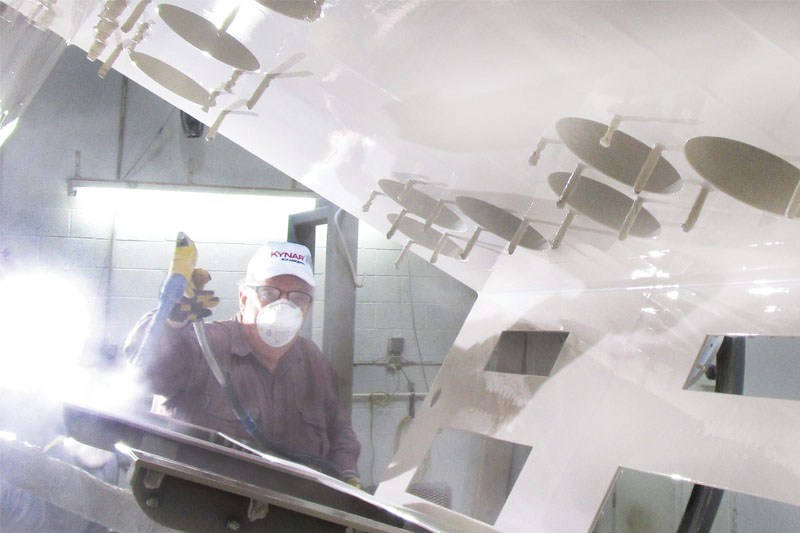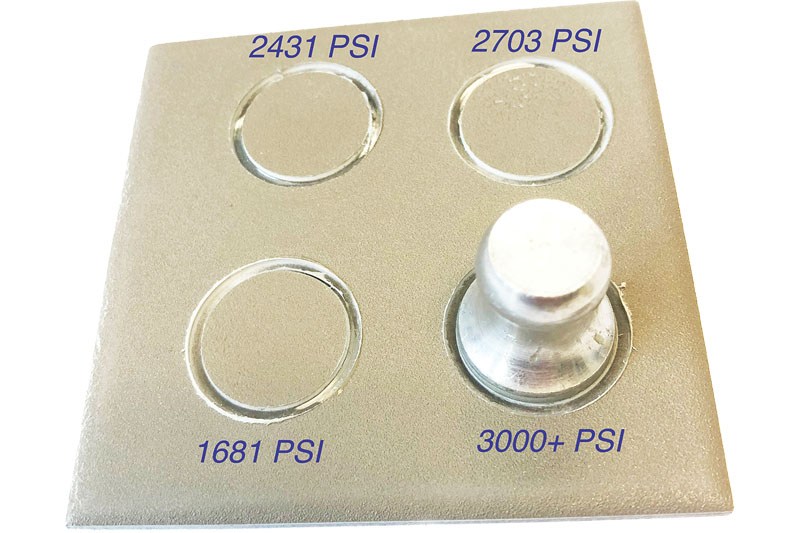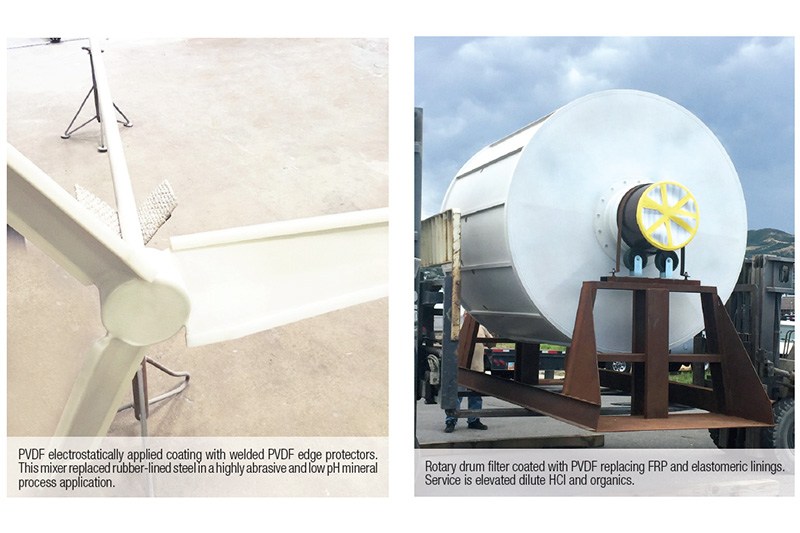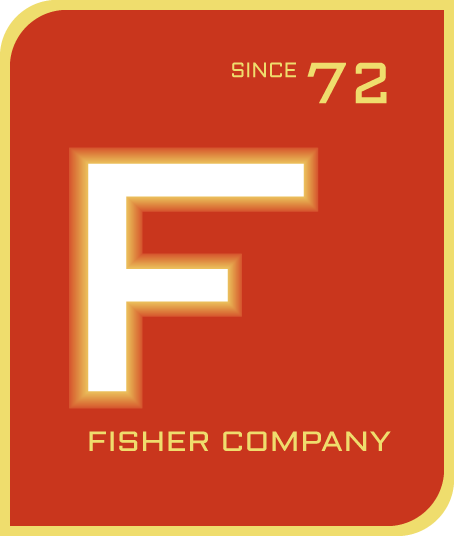Prevent Corrosion with Kynar® PVDF
PVDF has a proven history of use in the mining and mineral processing industries because of its robust chemical resistance, thermal rating, abrasion resistance and mechanical integrity system. Fluoropolymers are a family of polymers possessing high chemical resistance and high temperature stability. In that family, Polyvinylidene fluoride (PVDF) is one of the most versatile materials of choice for handling acids, chlorides and mixtures of chemicals. Piping systems, pumps, tower packing, tubing, valves, fittings, nozzles and filter systems made from PVDF are all readily available stemming from many other applications where PVDF is used such as in the general chemical handling industry and pulp and paper bleaching, chlor-alkali production, bio-pharmaceutical processing and semiconductor manufacturing.

Figure 1. Injection molded components and reinforced vessel for mineral processing Graphic courtesy of Arkema
The mining and mineral processing industry has plenty of corrosion challenges at every turn from exploration to separation to purification. Users have become aware of some shortcomings like observable and premature failures of common fiberglass-reinforced plastic (FRP), elastomeric and urethane linings in harsh thermal environments and the industry is searching for longer-life solutions. Mixers and agitators heretofore lined with rubber, some up to 8 inches in diameter, are now being lined with thick Kynar PVDF coatings for aggressive chemical scurries and low pH acidic conditions.
Similar to the problems with mixers and agitators, rubber and FRP have also been used in process filtration, such as in rotary drum filters, and have often been less than satisfactory. New technology for thick Kynar PVDF coatings is available to solve the challenges of corrosion and abrasion.

Figure 2. Kynar PVDF tower packing. Graphic courtesy of Arkema

Figure 3. PVDF piping components. Graphic courtesy of Arkema
Why PVDF?
PVDF is a high-performance polymer widely used across industries because of its unique properties. Chemical and abrasion resistance, sustained mechanical integrity at elevated temperatures, UV stability and good flame and smoke properties make PVDF a versatile material whose performance is appreciated in many industries (1). In its natural, unfilled form, PVDF is a high-purity fluoropolymer, utilized in applications where the end product’s purity cannot be compromised by even the smallest of contaminants or leachables. Thus, PVDF is one of the world’s most widely used fluoropolymers in industries for chemical, semiconductor, food and beverage, and mineral processing.
With different grades being offered commercially, PVDF is available in many processing components. PVDF resin grades have flexural moduli ranging from 10,000 to 1 million psi. The variations in flexibility of the polymer are attributed to tailoring the chemical structure of the chemical backbone to produce materials termed as PVDF homopolymers or PVDF copolymers. No fillers or plasticizers are added to PVDF to obtain the flexible performance (2). Piping systems, flexible tubing, fittings, pumps, valves, tower packing, wire and cable components and membranes are just a few examples in which PVDF and PVDF copolymers are utilized. Choosing the proper PVDF grade for the desired component is important in maximizing the service life of the system.
Standard PVDF homopolymers and some PVDF copolymers have a maximum use temperature of 150°C. Combined with their robust chemical resistance ranging from pH of <1 up to 13.5 for certain grades, PVDF and PVDF copolymers are a top-choice material of construction for the mining and mineral processing industry. Additionally, new technologies are available that enable PVDF coatings to replace rubbers, fiberglass, urethanes and epoxies as corrosion barriers to protect metal substrates. Case histories are included demonstrating the successes of new PVDF powder coatings application technology in providing solutions for challenging mineral processing.

Table 1. Tensile strength at yield (psi) of PVDF grades in six-month outdoor exposure in Pennsylvania.(3)

Table 2. Abrasion resistance of various materials.(5) Taber Abrasion Ring CS-10; mg/1,000 loss using 1 kg load
Chemical resistance
The fluorinated backbone of the PVDF polymer is the driving force behind its good chemical resistance. By weight percentage, standard PVDF homopolymers are 59.4 percent fluorinated and flexible Kynar PVDF copolymers are up to 64 percent fluorinated.
In the mineral processing industry, corrosion in acidic and chlorinated environments is a key challenge for engineers and maintenance professionals to overcome. While handling high concentration acids seems to be fairly common for metals, those materials can be quickly corroded in low acidic environments and acid mixtures that contain sulfur and chlorides. PVDF polymers can handle acids at both high and low concentrations and elevated temperatures, providing a cost-competitive solution for replacing metals.
Typical acids handled by PVDF include sulfuric (up to 97 percent for standard PVDF and 98 percent for Kynar Flex copolymers), methane sulfonic, acetic, nitric, phosphoric, chromic, hydrochloric, hydrofluoric and hydrobromic acids. Additional commonly handled chemicals include metallic chlorides, methane bromine, iodine, hydrogen sulfide, salt water and deionized water. The manufacturers of PVDF and PVDF copolymers as well as PVDF piping manufacturers offer chemical-resistance guides as an important resource to consult for understanding the temperature limitations in each chemical service. Table 1 lists the mechanical properties of various PVDF grades in outdoor chemical-resistance testing.
Abrasion resistance
The abrasion resistance of materials in the mineral and mining industry is also a key property to consider when designing systems for maximum longevity. Mineral processing carries an abundance of solids and liquids mixing together to create slurries. The flow of the slurry can cause an extremely abrasive environment. When the viscosity of the liquid is low, particulates can accumulate at the bottom of the system, thus creating an increased incidence of wear.4 In high viscosity situations, the flow of the viscous materials also can create highly abrasive environments throughout the entire system. PVDF is one of the most abrasion-resistant materials. Table 2 highlights its performance versus other commonly used materials in a Taber abrasion test. In this test, the lower the weight loss, the less material that has abraded off, signifying the best performance. Both PVDF homopolymer and PVDF copolymer versions used in spray-applied powder coatings demonstrate the same relative abrasion values in this test.

Figure 4. Kynar Flex PVDF coatings versus metal in two weeks of chlorine exposure. Graphic courtesy of Arkema
PVDF coating technology: Innovation leads to new solutions
Stemming from its use in piping, pumps and other processing equipment, the legacy of PVDF success has now been translated into powder coating technology. PVDF powder coatings offer a variety of benefits for protecting metal substrates from corrosion. The aforementioned properties of abrasion and chemical resistance are crucial reasons for PVDF coating adoption into the mining and mineral processing industry.

Figure 5. Application of electrostatically sprayed PVDF powder coatings. Graphic courtesy of Fisher Company
Traditional coating/lining equipment includes rubber, fiberglass composites, urethane and epoxy coatings (6). While each of these systems has a niche and proven market, they are not fluorinated polymers and thus lack the combination of enhanced chemical, corrosion, and abrasion resistance. PVDF can offer performance improvement in harsher applications that require a broader range of chemical and thermal resistance. Furthermore, PVDF has no talc, fillers or stabilizers that would leach out over time and could subsequently cause embrittlement of the coating or compromise product purity.

Figure 6. Adhesion testing of PVDF coatings bonded to metal substrate. Graphic courtesy of Fisher Company


Figure 7. Case histories of PVDF powder coatings in various services and processing equipment for the mining and mineral process industry. Graphics courtesy of Fisher Company
Adhesion to the metal substrate as well as consistency in coating application are major factors that can affect service life. Choosing an experienced coating manufacturer in PVDF resins that is recommended by the manufacturer based on previous end user input is suggested. Figure 6 shows test results for a PVDF electrostatic coating bonded to metal substrate. The maximum this apparatus is able to measure is 3,000 psi. Note the failure mode in every instance is between the adhesive of the dolly to the surface of the PVDF coating.
The universe of PVDF electrostatic coatings is progressing further than ever due to recent innovations and technological advancements. PVDF powder coatings as thick as 250 mils can be electrostatically sprayed for a corrosion barrier that is clear, abrasion- and chemical-resistant. These thicknesses above a quarter of an inch allow the user to machine back the internals of the PVDF to exact tolerances to enable the various parts to fit together. This is a significant advantage over rubber and glass alternatives. Figure 7 highlights some case studies in which PVDF coatings performed superbly in mineral processing applications.
Conclusion
PVDF has a proven history of use in the mining and mineral processing industries because of its robust chemical resistance, thermal rating, abrasion resistance and mechanical integrity. With proven success in piping, pumps and other processing equipment, new technology in PVDF powder coatings has found new applications and new successes. The advent of thick PVDF coatings up to 250 mils gives maintenance and engineering professionals in the mineral processing industry new options to have chemical- and abrasion-resistant barriers for protecting metal substrates.
Authors’ note: The authors would like to thank George Fisher of Fisher Company, North Salt Lake, Utah, for his expertise in PVDF powder coatings. His valuable input as well as the pictures he provided (Figures 5, 6 & 7) help illustrate the application and utilization of the PVDF coatings.
Prevent Corrosion with Kynar® PVDF-link to online article on Processing Magazine
References
- Dennis, Gary. Advanced Industry Applications for PVDF Based Resins, The IAPD Magazine, April/May 2002. Pp 30-31.
- Amrute, Mandar. PVDF and PVDF Copolymers – The latest materials on the block, Chemical World, August 2010. Pp 66-67.
- T.E Cauffman, R.H Markowski, “Chemical Resistance – Kynar® Grades”, Atochem North America, No. 2334, August 20, 1990.
- Mular, Andrew L.; Mineral processing plant design, practice and control: Proceedings, Volume 1, SME, 2002. Pp 1,430.
- Hanselka, R., Williams, R., Bukay, M. 1987. Materials of Construction for Water Systems Part 1: Physical and Chemical Properties of Plastics. Ultrapure Water. July/August 1987. Pp 46-50.
- Glein, Gary Alan. Metal, Fiberglass, and Thermoplastic Tanks and Piping, One Petro, March 1996.

